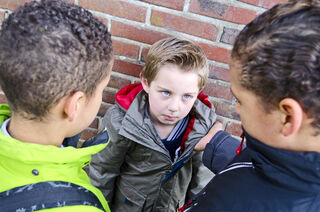Bullying
Bullying: It's Not Just for Kids
Part 2 of 4: Lieutenants and Toadies
Posted October 14, 2021 Reviewed by Vanessa Lancaster
Key points
- October is National Bullying Prevention Month.
- Bullies do not act alone. They often bully with lieutenants and toadies who each get psychological rewards from the bullying.
- As a group, the chief bully, lieutenants, toadies reinforce each other to perpetuate the bullying.
In the first post of this four-part series, I delved into the internal psychology of a typical childhood bully. But bullies, like other human beings, are social creatures – they don’t act in isolation.
A bully has allies: For want of better terms, I will divide these into two categories that are not mutually exclusive: lieutenants and toadies.
Lieutenants are other kids who form a cadre around the bully, sometimes referred to as the bully’s gang: think for example of the small group of guffawing chuckleheads orbiting Biff in the movie Back to the Future.1
What force pulls some kids into orbit around a bully? One is social: humans, like all primates, have a natural tendency to organize into hierarchies, and in any group, only one individual can be top dog. So like-minded bullies in a social setting will form a hierarchy, with a bully-in-chief at the top and a group of subordinates (the gang) underneath.
Human personalities vary; we are not all equally hierarchical in our social behavior, but bullies tend to be more hierarchical and authoritarian than average. Why would this be? As described in Bullying Part 1, bullies act out of an internal sense of insecurity, and they attack their victim because the victim, just by being who he is, undermines the bully’s sense of self-esteem.
A closely related personality trait is narcissism. Narcissists also act out of deep-seated insecurity wed to fear of inferiority – that is why they constantly need to use external evidence to remind themselves and others of their superiority. Examples include engaging in self-adulation and seeking the praise of others; repeatedly mentioning their awards, titles, trophies, degrees, ranks; acquiring power, wealth, status symbols, attractive mate(s), etc.
Because bullying is closely related to narcissism at its psychological roots, narcissists are often bullies, and bullies are strongly motivated by narcissistic rewards - particularly social power. That means that most bullies wish to be the top dog whenever possible. The bully’s gang comprises other bullies who subordinate themselves because they can’t individually unseat and replace him. They settle for being lieutenants, and in return, get to do some bullying themselves so long as it doesn’t interfere with the bully-in-chief.

Lieutenants also get the consolation prize of social affiliation (i.e., they get to be part of the gang. Like other social groups, the gang provides emotional support and physical protection to its members). Membership in the gang is reinforced by singling out and bullying outsiders. In group settings, this motivation – the identification and persecution of outsider(s) to cement loyalty within the in-group – often becomes paramount.
The oft-assigned middle school novel, Lord of the Flies, in which children are trapped together on a desert island, provides a literary illustration of this phenomenon: a few bullies maneuver themselves to the head of a tribe and then proceed to isolate, persecute, and eventually murder a subset of the others to consolidate this social organization.2 As alluded to at the novel’s conclusion, and as will be mentioned in Bullying Part 4, this form of human behavior is sadly not limited to children.
Toadies fall below lieutenants in the bullying social hierarchy. A toady is too vulnerable to be much of a bully himself. He affiliates with the bully-in-chief by sycophantically admiring and applauding whatever the bully does. For an example from popular culture, think of LeFou, the half-sized sidekick of the bully Gaston in Disney’s animated version of Beauty and the Beast. LeFou sings Gaston’s praises to cheer him up when the bully has suffered a narcissistic injury (romantic rejection by the village beauty).3
A practical explanation for the toady’s behavior is that he hopes to get some protection and avoid being a target of the bully by becoming his ally. And this usually works: the bully-in-chief curbs his own attacks and shields his toady, at least in part, from attacks by his lieutenants or outsiders. At a deeper psychological level, toadies have similar motivations to the bullies with whom they affiliate. They often derive at least some vicarious pleasure from witnessing a bully’s behavior. This becomes apparent if the toady is ever put in a position of power: given the opportunity, a toady will often bully those who are even more vulnerable.
What does the bully-in-chief get from his lieutenants and toadies? Like his lieutenants, the bully-in-chief gets the social reward of being part of a group – a nearly universal human need. Narcissistically, bullies also thrive on having an audience ready at hand to endorse and applaud their behavior enthusiastically. During any brief lapses when the bully is conscious of his vulnerability (i.e., because he’s down, depressed, feeling oppressed, or underappreciated), his allies are there to buck him up (“...No one’s slick as Gaston! No one’s quick as Gaston! No one’s neck’s as incredibly thick as Gaston!!...”)4
Finally, allies are of practical use. If an authority figure or physically stronger person gets involved, the bully’s allies support him. They can back him up verbally, and (conditions permitting) physically, in a dispute he can’t win by himself.
With this, I am done exploring some of the psychological and social features of childhood bullying. In Bullying Part 3, we will explore how this maps onto adult bullying.
References
1. Zemeckis, Robert, director. Back to the Future. Universal, 1985.
2. Golding, William. Lord of the Flies. New York: Perigee, 1954
3. Trousdale, Gary & Wise, Kirk, directors. Beauty and the Beast. Disney, 1991
4. Ashman, Howard, lyricist (source, footnote 3).




